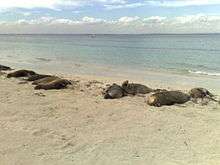Carnac Island
Carnac Island is a 19-hectare (47-acre), A Class, island nature reserve about 10 km (6.2 mi) south-west of Fremantle in Western Australia.
History
In 1803, French explorer Louis de Freycinet, captain of the Casuarina, named the island Île Pelée (Bald Island). It was also known as Île Lévilian and later Île Berthelot. In 1827, James Stirling changed its name to Pulo Carnac Island in honour of John Rivett Carnac, Second Lieutenant on his ship HMS Success. "Pulo" is Malay for "Island"; it is not known why Stirling included the term, and it was soon dropped. In the early days of the Swan River Colony the island was used as a penal settlement for Indigenous Australians.
 Carnac Island photographed from C. Y. O'Connor Beach |
 Sea lions on Carnac Island |
 Location of Carnac Island, Western Australia |
Fauna
The island is home to Australian sea lions, bottlenose dolphins and a large range of marine bird life. It is particularly noted for the abundance of snakes, particularly tiger snakes, which live there. For this reason, very few people venture there. There is no permanent fresh water, providing a challenge for the animals that live there. The origins of the tiger snake colony has attracted significant debate and research into how that species has adapted to a harsh island habitat.
Carnac is classified as an Important Bird Area because it supports a large colony of the vulnerable fairy tern, as well as small numbers of other nesting seabirds.[1]
See also
References
- ↑ "IBA: Carnac Island". Birdata. Birds Australia. Archived from the original on 6 July 2011. Retrieved 2011-06-13.
- Carnac Island Nature Reserve : management plan [Perth, W.A.] : The Commission, 2003. Management plan (Western Australia. Dept. of Conservation and Land Management) ; no. 47
Coordinates: 32°7′22″S 115°39′49″E / 32.12278°S 115.66361°E